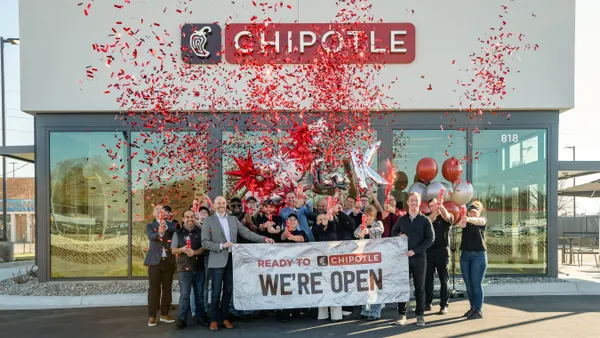When Rob Lynch joined Papa John's as CEO in the summer of 2019, he inherited a chain battered by controversy and steep revenue declines. Founder and former CEO John Schnatter’s messy and highly publicized ouster in 2018 had become emblematic of the pizza chain, and successor Steve Ritchie was accused of enabling inappropriate corporate culture as well.
But Lynch quickly identified points of stagnation within the chain, developing an aggressive menu innovation strategy — a major change for the company, which previously didn’t stray from its core offerings — and invigorating company morale. On day one of his tenure, Lynch was on the phone with franchisees to learn about their concerns and challenges, a Papa John’s spokesperson said.
This collaborative approach helped grow operator confidence and openness to a brand overhaul, which laid a strong foundation that fueled record-breaking sales growth in 2020. When Lynch took over, Papa John’s reported a total revenue decline of 7% to $399.6 million in Q2 2019. Fast forward to Q3 2020, and the chain’s revenues were up 17% to $472.9 million and same-store sales grew 24% in North America — marking six straight months of comp sales growth.
Innovation, financial support attracts lucrative operators
Since taking the helm, Lynch has focused on marrying strong marketing with dynamic new offerings to differentiate Papa John’s from rival pizza chains. The two-pronged strategy produced the highly successful Papadia and Shaqaroni menu innovations, launched with TV campaigns featuring brand ambassador Shaquille O’Neal. Both of these concepts don’t put operational strain on franchisees because they use existing ingredients and preparation methods, which has attracted lucrative operators to join the chain, Lynch said.
"Sometimes what gets lost [with innovation] is making it as seamless and as productive as possible for both the supply chain and the operations. … That's what makes all the difference when you're talking to the operators and trying to get them to buy into the innovation mindset," Lynch said.
Lynch credits the $80 million financial support program for franchisees launched in 2019 with positioning the chain for success during the pandemic. The third quarter 2020 marked the final period of the program, which helped operators improve efficiencies.
"Our franchisees had gone through some really challenging times [in 2018 and 2019]. … The business franchise cannot be successful if franchisees aren’t successful," Lynch said. "Now, they don’t need [support]. Their restaurants are more profitable than they’ve ever been and they’re generating a lot of cash flow, which we want them to reinvest back into the business in the form of unit growth and development. So it really is a virtuous cycle."
The strategy has already paid off in big ways. In September, Papa John’s signed one of its largest traditional store development deals in North America in over two decades with HB Restaurant Group. The franchisee will open 49 new Papa John’s restaurants in Pennsylvania and New Jersey over the next eight years.
"Communication is key, and making sure that all the constituents are on the same page and swimming in the same direction," Lynch said. "I think that’s a testament to how we built the foundation for this relationship between our franchise and franchisees, and we were able to execute really well on the restaurant level and keep our restaurants open, and our growth is an output of that work."
There is plenty of white space for the chain to capture in the U.S. market, where it isn’t as entrenched as rivals like Domino’s and Pizza Hut, Euromonitor analyst Matt Godinsky said.
"Papa John's has a lot fewer outlets than its main competitors, both domestically and abroad,” he said. “There's a lot of room for them to grow there. And I think that they're definitely strategizing and thinking about how they can build on this current boost and make it permanent."
A delivery-driven future
The partnerships with restaurant delivery aggregators under Lynch, and the company’s growing focus on digital offerings and loyalty, also primed the company to reap the benefits of contactless diner behavior amid the pandemic, Godinsky said. Many of the 8 million new customers Papa John’s has attracted so far in 2020 have entered through the chain’s loyalty program, and have higher frequency and ticket prices.
Lynch told investors in November that delivery partners like DoorDash will improve throughput for franchisees and help manage labor. Sales in the third-party delivery channel have increased from 2% to 6% of total sales in the past six months, and continue to drive incremental profitability.
Focus on delivery and mobile pickup will also inform future store design, Papa John’s Chief Development Officer Amanda Clark said, and the chain expects diner demand for efficient, contactless experiences to hold steady in a post-pandemic environment.
"All of the strategic priorities that we put in place back in 2019 are the same as what's in place now, we're just further along the path than we thought we would be," Lynch said. "And that gives me a lot of excitement and confidence in our future, and how we're going to continue to perform throughout the balance of the pandemic."



 Read more
Read more







